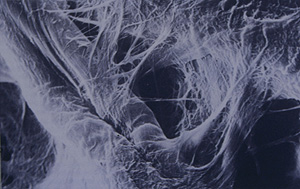
Basic Concepts
|
|
In order to understand the deterioration mechanisms of specific formats, you need to be familiar with several basic concepts and processes. This section will address the difference between organic and inorganic materials and the types of chemical reactions that affect collections. A basic understanding of these subjects will inform the discussions of deterioration mechanisms throughout the course.
1 Organic/Inorganic Materials
Organic materials include wood, paper, textiles, and animal products like ivory and leather. Other organic materials are not as obvious, such as coal or fuel oil, which are derived from fossilized plants and animals. Plastics and other synthetic materials made from plant-based chemicals may also be organic. All organic material deteriorates over time.
Inorganic materials include stone, metal, ceramic, and glass, which are all made from rocks or minerals. Some inorganic materials are found in paper collections; photographs contain metallic particles, and some pigments and inks contain minerals or metallic oxides. Metal particles can even be found in the paper itself.
Inorganic materials are generally stable on their own, but they can react with other elements to cause deterioration. Certain metals react to the cellulose in paper, particularly iron, copper, and platinum. Like organic materials, inorganic matter may be synthetic or natural; some pigments occur naturally as minerals, but may also be manufactured from other inorganic materials.
2 Chemical Deterioration
Chemical reactions are the driving force behind the deterioration of collections. In practice, chemical reactions are very complex. Often one reaction will initiate a series of others, and may occur simultaneously. The most common chemical reactions seen in archival collections are described briefly below.
Hydrolysis
In the simplest terms, this is the chemical reaction of a compound with water to form one or more new compounds. In acid hydrolysis, which is the reaction that plays the largest role in the degradation of paper, acid within the paper reacts with water (moisture in the air), causing breaks in the chains of molecules that make up paper and ultimately making it weak and brittle.
Hydrolysis is also a factor in the degradation of other materials, including leather. In leather, sulphur dioxide is absorbed from the atmosphere and converted into sulphuric acid in the presence of an oxidant (see the explanation of oxidation below). The sulphuric acid catalyzes hydrolysis of the collagen in leather, weakening the leather by breaking down the molecular chains within it (a process called depolymerization).
Oxidation
Oxidation is a chemical reaction that involves the loss of electrons from an atom or a molecule. Oxidation requires an oxidizing agent (an oxidant), such as oxygen in the air, ozone, or pollutants such as nitrogen oxide. Light, especially ultraviolet light, acts as a catalyst in activating these oxidants; this is referred to as photomechanical deterioration.
Oxidation causes paper to weaken, and oxidation of lignin (a naturally occurring organic polymer found in paper) plays a role in the darkening of poor quality paper. In addition, metal particles present in paper or inks can be oxidized, producing acids that degrade the paper through hydrolysis. As noted above, oxidants play a part in the acid hydrolysis of leather by converting sulphur dioxide into sulphuric acid.
Redox (Oxidation-Reduction)
The complementary reaction to oxidation is reduction, which involves the gain of electrons by an atom or a molecule. Redox reactions typically occur in photographs containing silver image material. In the oxidation-reduction process, the silver in the image is attacked by oxidants in the atmosphere, such as pollutants and paint fumes. This forms new, colorless silver compounds. During the reduction part of the process, the silver may be turned back into metallic silver but deposited in a different location in a different physical form. Resulting damage can include silver mirroring, loss of detail, and fading of the image.
|
Copyright© 2015 Northeast Document Conservation Center |


